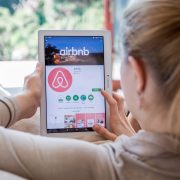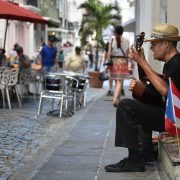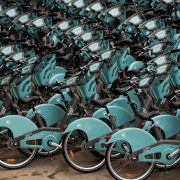One of the key ingredients of a great entrepreneur is the ability to constantly ask yourself, “how can I make this better?” This is a question Airbnb co-founder Joe Gebbia has been asking himself his whole life. And it was this innate desire to innovate and improve on existing models that has taken Airbnb from a fringe Silicon Valley experiment to a household name.
Natural-Born Innovator
Like all young kids his age, Gebbia loved the Teenage Mutant Ninja Turtles. He also loved to draw. Taking his passion for the pizza-loving cartoon turtles to the next level, he dedicated many hours to drawing pictures of the show’s characters. It wasn’t long before his classmates started noticing his drawings and asked him to draw pictures for them as well. This gave Gebbia an idea.
Charging $1 for small drawings and $2 for larger drawings, he was able to run a successful side hustle as an amateur artist. In addition to the money, young Gebbia was also making his classmates happy. It was a win-win situation for all parties involved, or at least it was until the adults got involved.
As demand for these Ninja Turtles drawings increased, the schoolchildren had begun telling their parents that they needed more lunch money than usual. This created suspicion among the parents, who contacted the teacher wanting to know what was going on. As all signs pointed towards Gebbia, the teacher approached him and told him he had to stop selling his art.
As Gebbia tells Tim Ferriss in a podcast episode: “You could say it was my first brush with regulation.”
And as Gebbia got older, his desire to create value morphed into a desire to innovate and make things better. During his senior year of high school, the student body had unveiled the t-shirt for that year’s graduating class. Gebbia was not impressed. And while he had no background in design, he knew he could do a better job. So he set to work.
Teaching himself Photoshop, a program of which he had no prior knowledge, Gebbia was able to create his own version of the senior class shirt that was much better than its competitor. Providing his own funds for the production of the shirts, Gebbia turned his dream for a better shirt into a reality. But now he was left with an inventory of shirts with no buyers.
Many innovative people never succeed because they lack the ability to get an idea from prototype to shelf. Everyone wants to dream, but no one wants to work. This is precisely what sets Gebbia apart from all the rest.
He went around school selling his shirts to each of his classmates. Telling each the story of how he came up with the design for the new shirt, a feat he accomplished with great success. This lesson would come to be integral in his later successes.
Where Is the Music Coming From?
Gebbia’s desire to do things better can most certainly be credited for his success as an entrepreneur, but it also got him in a fair amount of trouble as a kid.
At the end of his freshman year of high school, Gebbia was immensely disappointed by the prank that year’s seniors had chosen. As always. Gebbia knew he could do better, and spent the next three years determined to come up with a better plan.
By pure happenstance, just a few weeks away from graduation, Gebbia learned that it was actually quite easy to gain access to his school’s intercom system. Creating a diversion, he was able to covertly steal the main office’s cordless phone. All he had to do was dial #00 and he would have access to every room in the school. The only thing was, he didn’t know what to do with all this power. Then it hit him: he decided to make a tape that would play Alice Cooper’s “School’s out for Summer” and Pink Floyd’s “Another Brick in the Wall,” better known by its chorus, “We don’t need no education.”
While he had initially expected the administration to discover the phone and shut down the prank quickly, the opposite happened. As the music came blaring over the intercom, complete pandemonium ensued. The faculty could not figure out how to turn off the intercom and the students were relishing every moment of the chaos.
As Gebbia casually fled the scene and walked into class, he saw students in multiple classrooms dancing on their desks. The prank was a success. However, the administration would eventually catch on, and this prank would result in a summer of manual labor at the high school.
But in his small county in Georgia, he was a legend: so much so that MTV aired an episode of High School Stories that featured the prank only a few years later.
“CritBuns”
His t-shirt endeavor had given him a love for design, so after high school, Gebbia attended Rhode Island School of Design. During the course of his education, Gebbia had proven himself more than capable of not only completing difficult design projects but also finding a way to get them funded and into the hands of consumers, something every entrepreneur needs to be able to do.
In art school, there are long periods in which students critique each others’ work. During these sessions, students sit on dirty, hard stools that were known for leaving black marks on the behind of the sitter after they stood up from the chair.
This was a problem so common among art students, that everyone had their own horror stories to tell. During his senior year, Gebbia decided he was going to fix this problem. Customizing foam, he created a cushion that would fit comfortably on top of the art school stools. Named “CritBuns” because their use was intended for long periods of critique sessions, Gebbia had created a solution to a widespread problem. But merely solving the problem for himself was not enough for him. He knew the other students would love these cushions if only they knew about them. They would also be willing to pay for them.
But spreading the word was not as easy as he thought. A couple of months before graduation, the school announced a design contest for a product that could be given out to the entire graduating class of 2005. This was perfect. Gebbia would be able to get his idea funded in addition to spreading the word about his cushions.
As luck would have it, Gebbia won the contest but, unfortunately, he had no idea how to create hundreds of CritBuns. Even worse, he had no idea how he was going to do it in time for graduation, which was now just four weeks away.
After making several calls to various prospective vendors, Gebbia was routinely told he would need at least six weeks to obtain the raw materials needed to make this a reality. But that wasn’t going to work and Gebbia was going to complete this project no matter what it took. After many phone calls and a little creative problem solving, Gebbia was able to produce the CritBuns. And the day before graduation, hundreds of the seat cushions arrived on campus.
Prototype to Shelf: the Power of Storytelling
One of the wonders of CritBuns was how they were sold. It was purely by word of mouth. The cushions may have been meant solely for art school students, but other consumers were finding uses for them. And every consumer had a story about their CritBun experience. Someone would tell the story of how the cushion had helped them or where they had used it, and the stories would resonate with other consumers. It was this experience that taught Gebbia the importance of storytelling when attempting to get a product from prototype to the shelf.
When he was selling his CritBuns in Japan, he was unable to rely on storytelling, as he did not speak the language. It wasn’t until he began working with a translator who could do the storytelling for him that be began moving the product. This would aid him later on with Airbnb.
After school, Gebbia continued to sell CritBuns while taking up residence in San Francisco. It was there where he met the other co-founder of Airbnb, his roommate Brian Chesky.
When the two wanted to attend a design conference happening in the Bay Area, where they lived, both were bothered when they realized that many not living in the area would be prevented from attending simply because hotel accommodations were either in short supply or too expensive.
In true Gebbia style, he was anxious to provide better solutions that would alleviate these problems. It was then the two decided it would be fun to purchase three air mattress and charge low rates to conference attendees who wanted to stay in their apartment with them. This original concept was meant to be strictly for conferences, as this was the direct problem at hand. They didn’t see at the time how this concept could be expanded to accommodate more consumers.
As it turned out, people loved this idea and, before they knew it, they were hosting the first three Airbnb guests in history. And while the idea was received well at the conference, especially since the guests were on stage as part of the presentation, the idea did not catch on. Just like the initial CritBuns, nobody knew about Airbnb, so it was not likely to get off the ground.
But that was before the 2008 Democratic National Convention.
Love him or hate him, Candidate Barack Obama was a sensation among politicos. As a talented speaker, Obama was able to pull in record-breaking audiences. And many of these attendees were young Americans, an age bracket historically apathetic about politics.
As a result, the Democratic National Convention had had to relocate to a larger venue in Denver than was originally planned. But the delegates coming into town were already grabbing up all the hotel rooms, making lodging scarce. And since it was in such high demand, hotels could charge astronomical prices for a room.
This gave Gebbia and Chesky an idea. They would relaunch Airbnb at the Democratic National Convention. Excited and sure of themselves, they contacted CNN and other news outlets to let them know but were routinely shut down. No one seemed to find their idea that interesting, especially during an election as historic as 2008.
Desperate for some media attention, they focused on bloggers. They may not have known how brilliant this plan was at the time, but they are both aware of it now. When it came to reporting on local news concerning the convention, the local news networks relied on local bloggers. Likewise, national news networks were relying on local news networks in Denver for their reporting on the upcoming National Democratic Convention.
Before they knew what was happening, they were being featured on prominent news networks and their website was being shared with millions of audience viewers. Within a few weeks, around 800 Airbnb reservations had been made for the DNC, and Airbnb was officially on the map. And the rest, as they say, is history.
Who knew that the young boy selling Ninja Turtles drawings would one day create a business that would completely redefine the way we travel? And while his high school administrators may not have thought much about his high school prank, Gebbia is truly an entrepreneurial genius.













